This is the first in the series of posts where I will go through some of the techniques you can adopt to improve the effectiveness of the content on your website. There are so many techniques out there, but what I will try to do here is to talk about the ones that I think are useful to us at Imperial. The first of which is content audits.
You may be doing an entire site redesign or updating a large section of your website. Before you push ahead with planning and producing all that lovely new content, you should first find out what you have there already, and how good it is. This is where a content audit comes in very useful. They are also a good thing to do from time to time in order to do a bit of housekeeping.
What is a content audit?
This involves creating a list (usually a spreadsheet) of all the content on your website and information about it. There are two types of information you will get from an audit:
- Quantitative: these include URL, titles, headings, word count, metadata, analytics, content owners etc.
- Qualitative: includes descriptions of the purpose of the page and an assessment of the quality of the content.
Ok, I admit it, audits are not the most riveting part of a website redesign project, and it can be a fair bit of work too (depending on the size of your site), but it is worth it. Trust me.

What are the benefits?
I am glad you asked. Audits are really useful in understanding how your current site works – how much content you have, how good it is, and what people are looking at. This will really help you make some decisions about whether you keep, improve or delete stuff on your site.
There are many benefits, but these are my top 5:
- Helps you understand how your site is structured: unless you know how your site is organised it is impossible to restructure it properly and make your site easier to navigate, and content easier to find.
- Retain only useful and relevant content: by assessing all the content on your site, you can decide whether it actually needs to be there; if it doesn’t you should remove it. Also if it is out of date then update it or remove it. Content audits very often result in smaller, more manageable websites!
- Discover hidden treasures: if you are doing a whole site redesign, you may unearth some great content lurking in the depths of your site that can be reused or repurposed.
- Improve the quality of your content: doing an audit gives you a rare opportunity to look holistically at your content and assess if your site is saying what you want it to say, and more importantly, doing what your users need it to do. Remember: your website is a reflection of your department and Imperial!
- Identify content gaps: you may have some high-level ideas about the content your site needs; by looking at what you currently have, you can easily see what is missing.
Do I have to do a full audit?
Yes and no. On a redesign of a fairly large and complex site then definitely yes. If you really don’t have the time or resources to do a full audit then there are two scaled-down versions:
- Partial inventory: audit only a subset of the site’s content. For example, the top few levels of the site. This will at least give you a nice overview of the breadth of your site.
- Content sample: This involves picking a sample of your site this could cover different types of pages for example a news page, a few course pages or a contact us page, and then carrying out a detailed audit on those pages.
These can still be useful, but are never a substitute for a full content audit.
If you still want to do a full audit, but don’t have the time and resources then you can speak to us in the Digital team, and we may be able to help or can recommend some agencies that could carry out an audit on your behalf.
How do I conduct an audit?
Hopefully you found this post useful and understand the value of auditing your content. If you are planning to do an audit of your site then I will be adding some more information on the web guide very soon. If you need some more advice then contact me.
In my next post I will be talking about some of the tools to help you carry out your audit.
Further reading
There are also some other great resources out there:
- 3 steps to prepare for an effective content audit (GatherContent)
- How to run the perfect content audit (GatherContent)
- Book – Content strategy toolkit by Meghan Casey